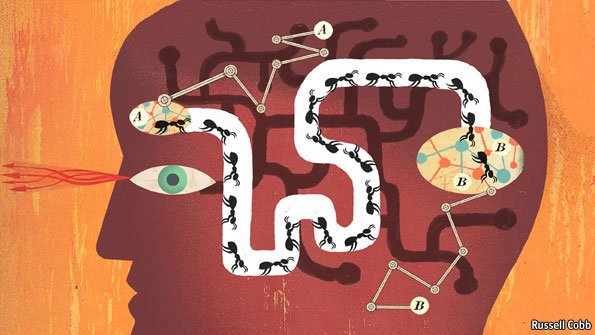Steemit as a Stigmergic Artificial General Intelligence with Human Values
I’ve been inspired to write this by @dana-edwards recent posts on stigmergic distributed collaborative organizations and swarm computers. Stigmergy is a mechanism of indirect coordination which is found in nature. For example, ants use stigmergic optimization to find the best route to food by leaving pheromone traces for the rest of the colony. Humans have been able to successfully model this phenomenon through ant colony optimization algorithms (ACOs) which have proven optimal for finding the shortest path in a graph from point A to B. Applications of modern ACOs range from vehicle routing to image processing for image edge detection and edge linking.
This post touches upon a more recent area of research involving the application of stigmergic optimization to large-scale human collaboration in decentralized networks and introduces a new idea of a self-optimizing artificial general intelligence (AGI) with human values achievable with swarm coordination that can potentially emerge through Steemit.
Steemit’s architecture may develop into a general-purpose swarm computer driven by stigmergic coordination. Human-Human stigmergy will be the main area of research for my upcoming posts as I attempt to develop a general-purpose stigmergic framework for mass collaboration that may be applied to Steemit and potentially evolve into an AGI with human values that recursively improves itself similar to that of a Gödel machine, leading into an “intelligence explosion.”
From Constructionist to Constructivist Approaches to AGI
The constructionist methodology is a traditional top-down approach to AI involving a hard-wired, complete architecture. For example, a constructionist approach may try to replicate and converge complex human processes such as perception, focus, and creativity into one system. These systems, which have remained the norm since the field’s inception more than five decades ago, are brittle and lack adaption outside its targeted domain. Due to the fragility and complexity of this top-down approach, the constructionist methodology is unlikely to create a true AGI capable of real-world introspection and self-improvement.
The constructivist methodology takes the opposite approach and focuses on building a system from the bottom-up, where a dynamic environment and initial “seed” program would interact to auto-generate the kinds of architectures needed to general-purpose intelligence. An example of a constructivist or seed AI is the Gödel machine, a theoretical design for a recursive self-improvement protocol which rewrites its own code once it can formally prove the new code provides a more optimal strategy. This approach has multiple limitations it must, if at all possible, overcome such as narrowing down the virtually infinite search space for proofs in a dynamic environment. Yet, even a Gödel machine with unlimited computational resources must ignore those self-improvements whose effectiveness it cannot prove.
While it has technical limitations, the Gödel machine poses a significant concern: how do we know it will align with and stayed aligned with human values and objectives which are likely to be under-specified and evolve over time?
Swarm intelligence, while seemingly complex, may be driven by a simple stigmergic coordination mechanism which may act as the seed program in a constructivist AGI that is “raised” by a decentralized network of humans and therefore adopts the values of humans. In fact, the same stigmergic behavior seen in bees is comparable to that of neurons in the brain, suggesting that a general-purpose stigmergic coordination seed algorithm is the underlying foundation for human intelligence.
Consider the following passage from a piece titled How the Science of Swarms Can Help Us Fight Cancer and Predict the Future by Ed Yong of Wired Magazine:
Thomas Seeley, a behavioral biologist at Cornell, used colored paint to mark bees that visited different sites and found that those advocating one location ram their heads against colony-mates that waggle for another. If a dancer gets rammed often enough, it stops dancing. The head-butt is the bee version of a downvote. Once one party builds past a certain threshold of support, the entire colony flies off as one.
House-hunting bees turn out to be a literal hive mind, composed of bodies. This is no cheap metaphor. In the 1980s cognitive scientists began to posit that human cognition itself is an emergent process. In your brain, this thinking goes, different sets of neurons fire in favor of different options, exciting some neighbors into firing like the waggling bees, and inhibiting others into silence, like the head-butting ones. The competition builds until a decision emerges. The brain as a whole says, “Go right” or “Eat that cookie.”
Blue jack mackerel merge into a bait ball, a torus that confuses predators.
Stigmergic Optimization is Already Happening on Steemit
This stigmergic coordination observed amongst both bees and neurons could even be analogous to the swarm behavior occurring on Steemit. At the time of writing this, 39 out of the top 50 popular posts include the word “Steem” or “Steemit” in their titles, suggesting an indirect consensus to upvote (or “waggle”) posts that further develop the Steemit platform. These posts vary from announcements of new Steemit GUI skins and mobile applications to anti-spam bots and communication platforms. Popular success stories from real people on Steemit in addition to the open realization of profits by content creators attract new members to the swarm, indirectly creating a viral network effect.
These factors of stigmergic coordination, guided by attractor tokens (Steem Dollars/Power), is enabling rapid self-improvement in the early stages of the platform. Through this stigmergic optimization, we are already exhibiting emergent behavior of an intelligent network. Steemit may develop from what is now largely a platform for user-generated content into a platform for general collaboration of ideas, solutions, innovation, and work; that is, if the swarm continues to travel in that direction through all its chaos.
References
Schmidhuber, Jurgen. "Godel Machines: Self-Referential ¨ Universal Problem Solvers Making Provably Optimal Self-Improvements." IDSIA.
Edwards, Dana. "Attention-Based Stigmergic Distributed Collaborative Organizations." Steemit.
Edwards, Dana. "The Swarm Computer." Steemit.
Edwards, Dana. "Attractor Patterns and Attractor Tokens." Steemit.
Thorisson, Kristinn R. "From Constructionist to Constructivist A.I."
Yong, Ed. "How the Science of Swarms Can Help Us Fight Cancer and Predict the Future." Wired.com.


This is an extremely interesting article! Good job combining two topics I'm interested in - AI and decentralization - in a way that kept me hooked from start to finish!
Very well written article!
It is very interesting how the model of steem can be compared to the workings of our consciousness.We are now reshaping our society with new structures that are somehow similar to natural models.
Great video also, thank you.
Thanks for sharing, soon we shall all be crypto
#matrix
I would replace the part which says "Artificial General Intelligence" with "Swarm Intelligence" and then I'd agree. AGI at this point is science fiction.
I think that a general purpose swarm intelligence that is self-optimizing satisfies the requirements of an AGI. AGI only sounds science fiction now because we've been taking the wrong approaches towards achieving it, i.e. by focusing on narrow AI. I see a swarm computer as a collective effort (driven by self-interest) to achieve AGI with human values. I also think we'll see it within the next few decades.
I also think that each node in a general purpose swarm network will gradually be replaced by narrow-AI algorithms and bots, from which I'm sure you can imagine a very complex machine intelligence emerging.
@miles2045 The word you're looking for is hyperspecialization driven by genetic or iterative algorithms.
Also @dana-edwards is right, general AI isn't possible at all it requires a concept of self or person as well as a concept of "other people" and our relationships with those people and that is a function of the carrier and processing systems, not the algorithms emulating them.
ARNN has potential in this but mimicking biology in silicon is horribly inefficient and until we have a theory of everything we can't really simulate full biologys per se.
@dana-edwards AGI is sci-fi but emulated whole systems intelligence models are a real thing, just really, really computationally expensive.
First steps have already been taken http://www.openworm.org/
Yes I squealed like a schoolgirl getting asked to prom too. :)
I define AGI as the ability to solve a variety of complex problems in a variety of complex environments. A recursively self-improving AGI must be capable of introspection, a sign of "self-awareness." I called the system a Stigmergic AGI because I think calling it a general-purpose self-optimizing swarm intelligence can be misleading, since I am operating under the assumption that stigmergy is a indirect coordination mechanism found in even single unit systems such as in the human brain.
Whether or not AGI is theoretically possible or not, I'll try to cover my thoughts in another post. We already know that general intelligence is possible.
Cyborg swarms with AI isn't in my opinion the same as AGI. AGI typically refers to a separate entity or thing and some people even claim it would be sentient. A cyborg swarm would be to think of the swarm as your new limbs or extrasensory capabilities but it's under your control and is part of you.
I upvoted You
Keep up the good work!